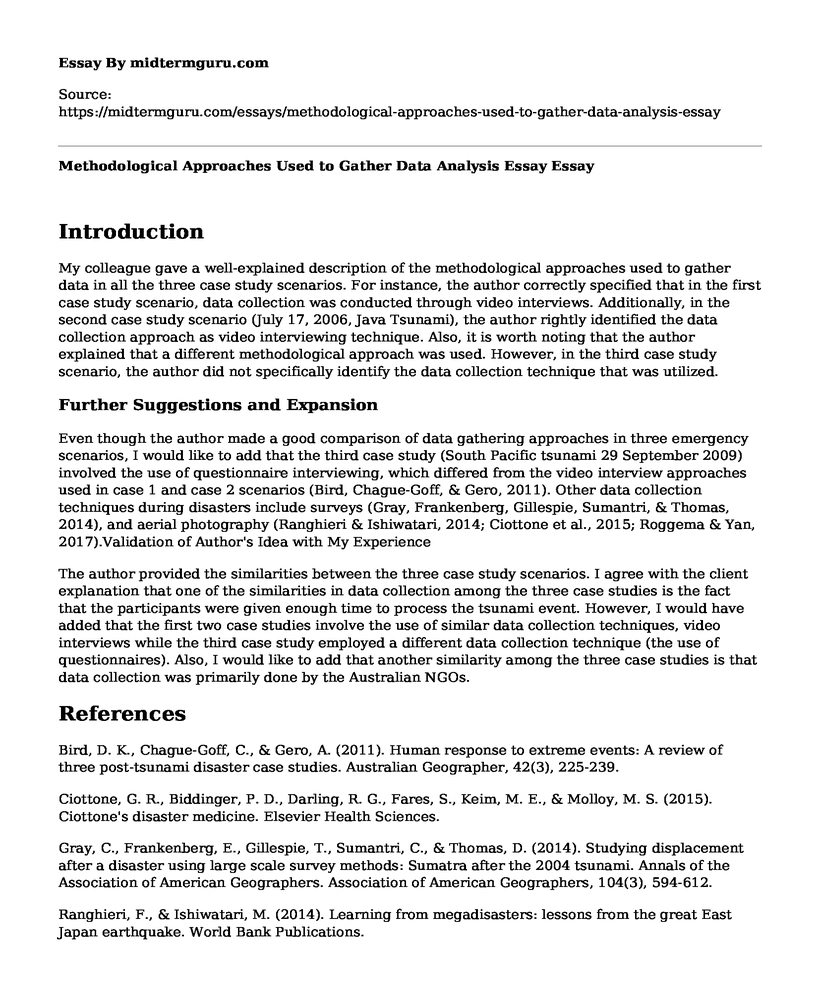Introduction
My colleague gave a well-explained description of the methodological approaches used to gather data in all the three case study scenarios. For instance, the author correctly specified that in the first case study scenario, data collection was conducted through video interviews. Additionally, in the second case study scenario (July 17, 2006, Java Tsunami), the author rightly identified the data collection approach as video interviewing technique. Also, it is worth noting that the author explained that a different methodological approach was used. However, in the third case study scenario, the author did not specifically identify the data collection technique that was utilized.
Further Suggestions and Expansion
Even though the author made a good comparison of data gathering approaches in three emergency scenarios, I would like to add that the third case study (South Pacific tsunami 29 September 2009) involved the use of questionnaire interviewing, which differed from the video interview approaches used in case 1 and case 2 scenarios (Bird, Chague-Goff, & Gero, 2011). Other data collection techniques during disasters include surveys (Gray, Frankenberg, Gillespie, Sumantri, & Thomas, 2014), and aerial photography (Ranghieri & Ishiwatari, 2014; Ciottone et al., 2015; Roggema & Yan, 2017).Validation of Author's Idea with My Experience
The author provided the similarities between the three case study scenarios. I agree with the client explanation that one of the similarities in data collection among the three case studies is the fact that the participants were given enough time to process the tsunami event. However, I would have added that the first two case studies involve the use of similar data collection techniques, video interviews while the third case study employed a different data collection technique (the use of questionnaires). Also, I would like to add that another similarity among the three case studies is that data collection was primarily done by the Australian NGOs.
References
Bird, D. K., Chague-Goff, C., & Gero, A. (2011). Human response to extreme events: A review of three post-tsunami disaster case studies. Australian Geographer, 42(3), 225-239.
Ciottone, G. R., Biddinger, P. D., Darling, R. G., Fares, S., Keim, M. E., & Molloy, M. S. (2015). Ciottone's disaster medicine. Elsevier Health Sciences.
Gray, C., Frankenberg, E., Gillespie, T., Sumantri, C., & Thomas, D. (2014). Studying displacement after a disaster using large scale survey methods: Sumatra after the 2004 tsunami. Annals of the Association of American Geographers. Association of American Geographers, 104(3), 594-612.
Ranghieri, F., & Ishiwatari, M. (2014). Learning from megadisasters: lessons from the great East Japan earthquake. World Bank Publications.
Roggema, R., & Yan, W. (2017). Tsunami and Fukushima Disaster: Design for Reconstruction. Springer.
Cite this page
Methodological Approaches Used to Gather Data Analysis Essay. (2022, Aug 18). Retrieved from https://midtermguru.com/essays/methodological-approaches-used-to-gather-data-analysis-essay
If you are the original author of this essay and no longer wish to have it published on the midtermguru.com website, please click below to request its removal:
- MBA Final Project Preparation: Qualitative and Quantitative Research
- Statistics Paper Example on Female Headed Households in Indonesia
- Methodological Approaches Used to Gather Data Analysis Essay
- SWOT Analysis on Connectivity, Culture, and the Future of Work at Uber
- Essay Sample on Summary of the Qualitative Research Applied
- Epidemiology Research: Cohort, Cross-Sectional, & Randomized Studies - Research Paper
- Activision Blizzard SWOT Analysis: Strengths, Weaknesses, Opportunities, & Threats - Research Paper







